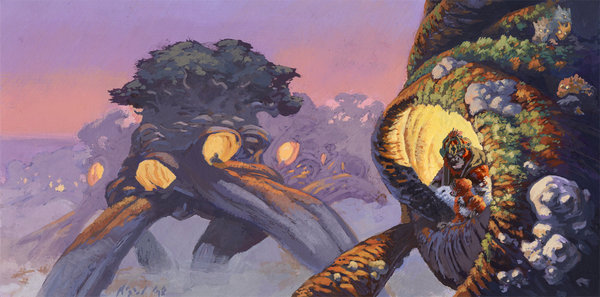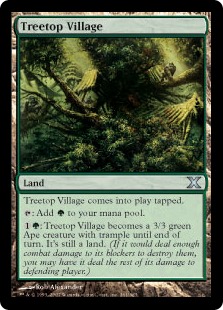As part of its “metamorphosis” announcement last year, Wizards of the Coast notified players that Magic 2016 will be the last core set they produce, as magic production changes to a sequence of two-set blocks. While we’ll have to wait until the summer to see if M16 sends core sets out with a bang (Force of Will reprint perhaps?) or a whimper (bushido is back!), its a good time to look back at the nine modern-legal core sets printed to date and see what they’ve contributed to the modern format.
The Top 10:
The highest impact cards that core sets have brought to modern
The fourth edition player’s guide describes scenarios in which a Lightning Bolt is used to kill a Hill Giant or War Mammoth. Who knew that two decades later that same lightning bolt would be the defining card of the game’s premier non-rotating format? A surprising M10 reprint with an equally surprising encore printing in M11, lightning bolt sets the bar for all other removal in modern, and creatures must notoriously pass the “bolt-test” to be considered for play (either the benefit of the creature sticking outweighs the risk of it being bolted OR it survives a bolt). As the most efficient and versatile removal spell there is, it’s a rare deck with mountains that doesn’t sleeve up a playset by default.
Modern features a plethora of excellent non-basic lands, encouraging players to run three or four colours and splash at will for specific combo pieces or hate cards. Blood moon punishes those who get too greedy with their mana bases by converting all of this “free value” into (most likely) useless mountains. Black/Green midrange decks in particular may only run two or three basic lands, meaning an unexpected blood moon can virtually lock them out of the game. This is coincidentally also part of the reason fetchlands are the preferred mana-fixing in the format, as they allow a player to retrieve basic lands in advance of the Blood Moon, improving the odds they can fight through it or remove it.
Technically three cards, but since you either play all of them or none I’m giving a single slot on the list to Urza’s Mine, Urza’s Power Plant, and Urza’s Tower. While originally conceived as a gimmicky way to ramp into massive Fireballs, the printing of increasingly powerful card selection and tutors has made bringing all three tron pieces together by turn 3 or 4 relatively trivial. The printing of cards to consume all of that quick colourless mana like Karn Liberated, Wurmcoil Engine and ultimately Emrakul, the Aeons Torn have solidified tron as a top tier competitive strategy in modern.
Scavenging Ooze is technically a reprint from the original commander decks, but has the feel of a core set original card since its first printing was in the modern era. “Scooze” goes a long way to keeping graveyard decks honest, and while anyone can maindeck a Relic of Progenitus, having your maindecked graveyard hate only hit your opponent, also gain you life, and act as a massive beatstick in the late game is usually a lot more relevant than a cantrip.
The first core set original to crack the top ten list, Young Pyromancer sees play in both modern and legacy which says a lot for its power level. Pretty much exclusively played in red/blue shells with Gitaxian Probe and other cheap cantrips, an unchecked pyromancer presents a stream of elemental damage or chump blockers that most modern decks struggle to handle without access to their sideboards.
Mana Leak has seen printing in four of the nine core sets to date, and I’m still not sure just how good the card is in modern. On one hand the format is fast, so players usually don’t have 3 mana available to pay their way out of the counterspell. On the other hand, there are decks like scapeshift and tron that do easily get out of reach of mana leak. If we’re looking for a tempo play Spell Snare or Remand are probably better, while if we’re looking to play a longer control game Cryptic Command and even Deprive are going to be more reliable. Mana Leak keeps appearing in top decks, so it clearly still has a niche despite the stiff competition.
Leyline of Sanctity is a remarkable card for the amount of impact it has on the format despite how little actual play it sees. The mere threat of a turn 0 leyline keeps burn and discard decks honest - usually forcing them to splash a second colour for enchantment removal. It also means that combo decks planning on targeting with their win condition (Scapeshift, Ad Nauseum, storm) need some way to deal with a leyline in their 75, whether its Echoing Truth, Cryptic Command, or Patrician’s Scorn.
Not that it really needed it, but Steel Overseer provides affinity with another two mana must-answer threat. While the overseer is not as resilient or fast as Cranial Plating or Arcbound Ravager, just a single activation can put the game effectively out of reach for the opponent, as Ornithopters and Blinkmoth Nexuses go from “+1 artifact count” to actual clocks.
In the world of Celestial Colonnade and Mutavault, its easy to forget that tenth edition provided a full cycle of monocolored “manlands”. Excusable perhaps since Forbidding Watchtower, Ghitu Encampment, and Spawning Pool have not done much in the format, and Faerie Conclave has only recently seen play in the Jeskai Ascendancy combo deck; but less so when one considers that the green land in the cycle has been at the top tables since the format’s inception. Treetop Village provides three power for (effectively) three mana and comes packed with trample as a form of evasion. Despite more expensive and powerful alternatives like Stirring Wildwood and Raging Ravine, Black-Green midrange players continue to run some number of villages in their decks attesting to the importance of the cheaper activation cost and trample.
And the last of the core set top ten goes to another tenth edition reprint in Hurkyl’s Recall. While the card really only has one use - defeating affinity - it excels at that purpose. The affinity player must either avoid overextending and thus give their opponent time to defend and counterattack, or overextend and potentially have their entire board lifted back into their hands for a mere two mana. As artifact hate has been excised from blue’s share of the colour pie in the modern era, this is an exceptional effect to have for decks like merfolk that can’t access alternatives like Stony Silence or Shatterstorm.
Honorable Mentions:
Core set contributions that are notable but don’t quite crack the top 10
Preordain - on one hand it’s the only core-set card banned in modern, on the other that means it no longer has any impact on the format.
Grim Lavamancer - probably the most criminally underplayed card in modern, but being underplayed means it doesn’t have much actual impact.
Primeval Titan & Summer Bloom - the “bloom titan” deck has been picking up steam, but has a ways to go to join the ranks of combo decks like Scapeshift and Splinter Twin.
Shatterstorm - not quite as important as Hurkyll’s Recall given the other artifact destruction options available in red, but it is usually the go-to affinity killer for decks that can support it.
Boil & Choke - the latter sees more play than the former, but both are relatively narrow sideboard cards that only really affect the extent blue players run non-shock dual lands or Orboro, Palace in the Clouds.
Pyroclasm - generally overshadowed by Volcanic Fallout and Anger of the Gods.
Master of the Pearl Trident & Phantasmal Image - these two cards go a long way to making merfolk a nearly-top-tier deck.
Gladecover Scout - gave the “bogles” deck enough cheap hexproof bodies to find some consistency.
Timely Reinforcements - A common sideboard consideration for any white deck looking to shore up aggro or burn matches.
Combust - Excellent sideboard card against Splinter Twin while also dealing with things like Siege Rhino and various merfolk.
Ajani’s Pridemate, Serra Ascendant & Squadron Hawk - the backbone of the “soul sisters” lifegain deck that occasionally spikes a tournament when the meta is right.
Wrath of God - overshadowed for the most part by Supreme Verdict and Anger of the Gods, the original wrath still sees some play, particularly when Thrun, the Last Troll is of concern.
Worth Noting:
Cards that have seen modern play, but have relatively low impact overall
Reprints
Duress
Ensnaring Bridge
Seismic Assault
Sleight of Hand
City of Brass
Blackmail
Bribery
Phyrexian Arena
Defense Grid
Shivan Reef (et al)
Polymorph
Mind Stone
Peek
Originals:
Chandra, Pyromaster
Hive Mind
Celestial Purge
Honor of the Pure
Baneslayer Angel
Elvish Archdruid
Back to Nature
Obstinate Baloth
Tidebinder Mage
Ensoul Artifact
Viscera Seer
And there you have it. All told just over 60 relevant cards from the 9 modern-legal core sets. While that may seem low, a new expansion would be a success for modern if it included 6 or 7 cards that saw modern play, and when we also consider that core sets were primarily designed to bridge new players into the game, the card count is actually quite respectable. I don’t think we’ll miss core sets in modern, but they have certainly been instrumental in defining the shape of the format and we’ll be living with the legacy of these nine (soon to be ten) sets for a long time to come.




